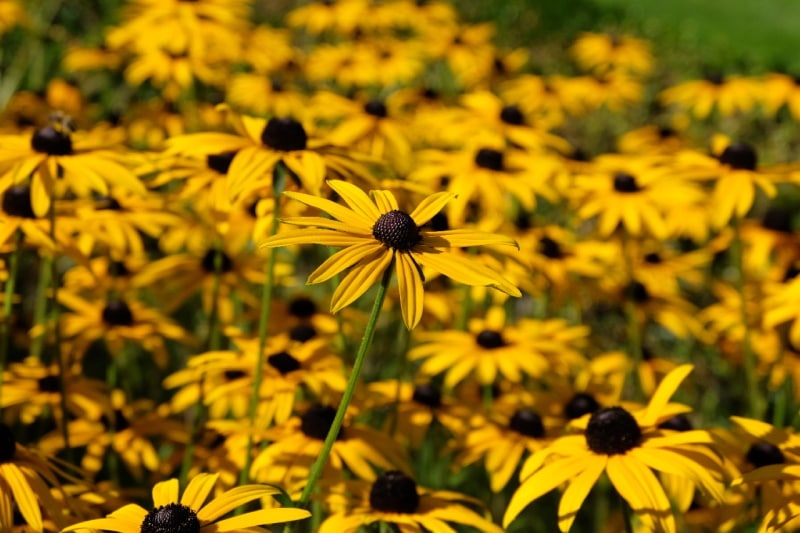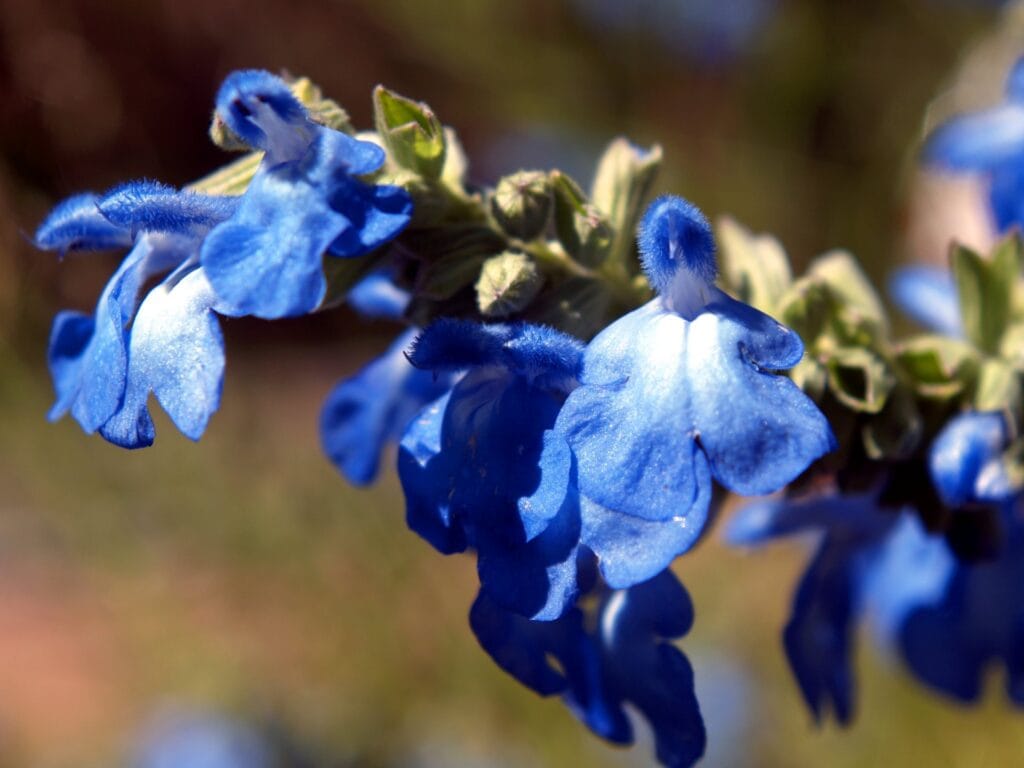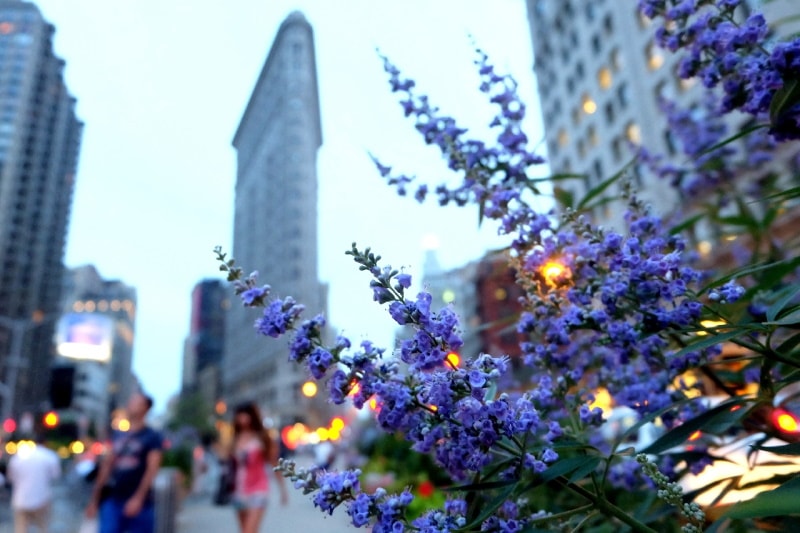35 Wildflowers That Grow in North Carolina (Identification Guide With Pictures)
-
Lindsey Lawson
- Last updated:

North Carolina is a breathtaking state when it comes to natural beauty. This coastal state has it all, from the mountainous regions to the sandy beaches and everything in between. Not only is this state home to some of the most beautiful wildflowers in the nation, but they have a season that spans from March until October to observe the gorgeous blooms.
Wildflowers are popularly observed along the roadsides of the Carolinas and can be found throughout the varied landscape. Since there are so many species, identification can be a bit tricky. In this article, we will talk about some of the most popular wildflowers you can find growing in the state to make it easier to pick them out when you have the pleasure of seeing them.
The 35 Wildflowers That Grow in North Carolina
1. Carolina Lily
| Scientific Name: | Lilium michauxii |
| Bloom Time: | July to October |
| Sun Exposure: | Partial sun |
| USDA Hardiness Region: | 6 – 9 |
Carolina Lily is North Carolina’s official State wildflower. This perennial wildflower is found in dry upland forests, slopes, and ridges in all areas throughout the state though it is much rarer in the coastal plains.
It is the only fragrant lily east of the Mississippi that is native to the United States. Its unbranched stem grows to between 2 and 4 feet tall with whorled leaves. It blooms orange and yellow speckled flowers during the summer with distinctly recurved petals.
2. Blue Star
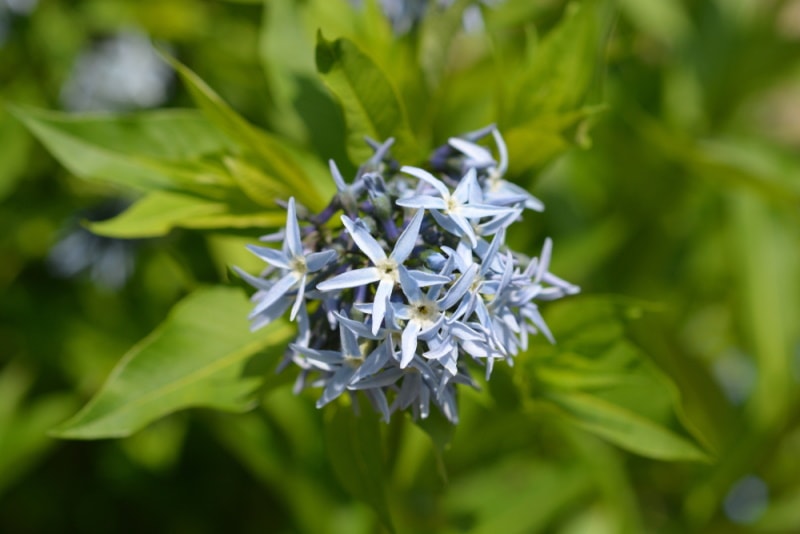
| Scientific Name: | Amsonia tabernaemontana |
| Bloom Time: | March to June |
| Sun Exposure: | Full sun, partial shade |
| USDA Hardiness Region: | 3 – 9 |
Blue Star which is also called Blue Dogbane or Eastern Bluestar is native to both Central and Eastern United States. It’s known for displaying clusters of small, light blue star-shaped flowers. The plant itself has narrow, bright green oval leaves that are pale on the underside.
Blue Star attracts many pollinators like hummingbirds, carpenter bees, butterflies, and moths. It is found in wet, sandy, soils near rocky woods and thickets. Blooms will appear around March and start tapering off around June.
3. Carolina Jessamine
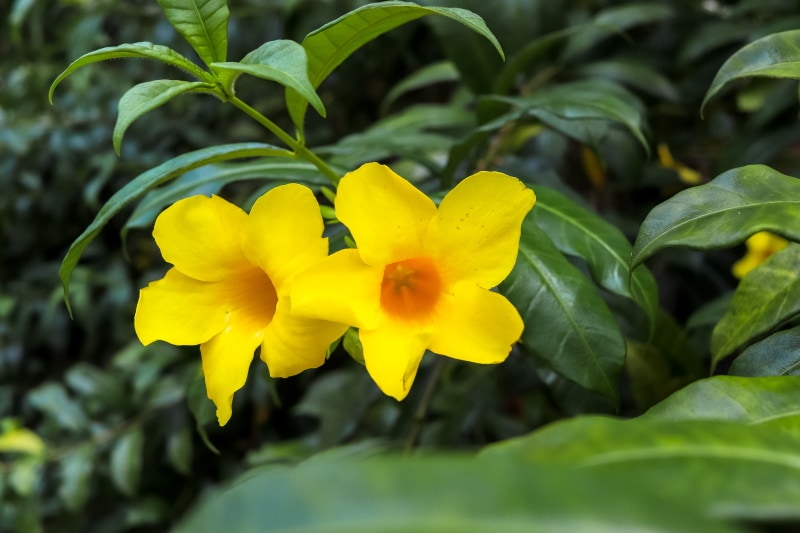
| Scientific Name: | Gelsemium sempervirens |
| Bloom Time: | February to May |
| Sun Exposure: | Full sun |
| USDA Hardiness Region: | 6 – 10 |
Carolina yellow jessamine is a vine native to the southern United States, Mexico, and Guatemala. It was named the state wildflower of South Carolina back in 1924. It features yellow funnel-shaped flowers that bloom as early as February. These fragrant flowers can reach up to 1.5 inches in length and may appear solitary or in clusters.
4. Eastern Columbine
| Scientific Name: | Aquilegia canadensis |
| Bloom Time: | April to June |
| Sun Exposure: | Full sun, light shade |
| USDA Hardiness Region: | 3 – 9 |
The Eastern Columbine is native to the Eastern half of the United States and grows well in a variety of conditions. Found near woodland edges and along riverbanks, this wildflower features red and yellow dangling flowers from a long, erect stem.
Blooms occur from April to June and are about 1 to 2 inches long with 5 petals and a lengthy, nectar-bearing spur. This wildflower is incredibly attractive to pollinators like hummingbirds and butterflies.
5. Green-and-Gold
| Scientific Name: | Chrysogonum virginianum |
| Bloom Time: | April to July |
| Sun Exposure: | Partial shade |
| USDA Hardiness Region: | 5 – 9 |
Green-and-gold flowers are woodland natives of the eastern United States from Pennsylvania down to Florida and as far west as Louisiana. This plant is low-growing and produces vibrant yellow flowers that are daisy-like in appearance. In warmer climates, the blooms will take off during the springtime but will become sparser during the summer.
6. Cardinal Flower
| Scientific Name: | Lobelia cardinalis |
| Bloom Time: | July to October |
| Sun Exposure: | Partial shade |
| USDA Hardiness Region: | 3 – 9 |
The cardinal flower gets its name from the red robes worn by cardinals in the Roman Catholic church. This beautiful wildflower is native to the eastern United States and features brilliant red blooms that begin during the summer and continue into the middle of fall.
These plants are distributed throughout the woodlands, wet meadows, and along ponds and streams in areas with partial shade. The cardinal flowers were selected as North Carolina’s Wildflower of the Year in 1982, 1983, and 2001.
7. Wild White Indigo
| Scientific Name: | Baptisia alba |
| Bloom Time: | April to July |
| Sun Exposure: | Full sun |
| USDA Hardiness Region: | 5 – 8 |
Wild White Indigo is a mound-shaped perennial native to the southeastern United States. It grows from 2 to 4 feet in height and has dark, blue-gray stems with alternate leaves and bright-colored blooms that appear from April to July.
It displays clusters of pea-shaped flowers that are only about 1⁄2-inch in length. The flowers can range from white to creamy yellow. The stems become bare during the winter, but their black seed pods typically stay attached.
8. Blue False Indigo
| Scientific Name: | Baptisia australis |
| Bloom Time: | April to July |
| Sun Exposure: | Full sun, partial shade |
| USDA Hardiness Region: | 3 – 9 |
Blue False Indigo is native to the dense forests and wooded areas of the central and eastern United States. This large perennial reaches nearly 3 to 4 feet tall and displays clusters of deep blue flowers that bloom directly from spikes.
It begins to bloom in April and lasts until July. These develop underground and become increasingly showy as they mature. Blue False Indigo was named the NC Wildflower of the Year in 1992.
9. Highbush Blueberry
| Scientific Name: | Vaccinium corymbosum |
| Bloom Time: | March to May |
| Sun Exposure: | Full sun, light shade |
| USDA Hardiness Region: | 3 – 8 |
The highbush blueberry plant is found throughout eastern North America and can reach 8 to 15 feet tall. It grows near higher-elevation forests, bogs, and swamps. It produces edible berries and blooms clusters of small white to pink bell-shaped flowers from March to May.
10. Garden Phlox
| Scientific Name: | Phlox paniculata |
| Bloom Time: | June to August |
| Sun Exposure: | Full sun to partial shade |
| USDA Hardiness Region: | 4 – 8 |
Garden phlox is a perennial wildflower that grows 2 to 4 feet tall. This North American native ranges from New York down to Georgia and as far west as Arkansas. It is found throughout the entire state of North Carolina. The fragrant, tubular flowers bloom in a variety of colors starting in the middle of summer and lasting until around mid-fall.
11. Butterfly Weed
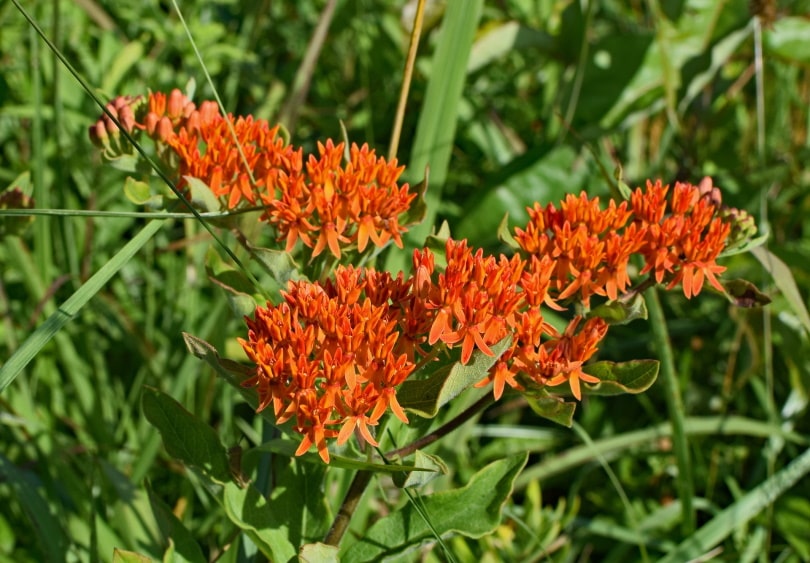
| Scientific Name: | Asclepias tuberosa |
| Bloom Time: | May to August |
| Sun Exposure: | Full sun, partial shade |
| USDA Hardiness Region: | 3 – 9 |
Distributed across the eastern and southern United States, butterfly weed forms clusters of bright orange to yellow-orange flowers atop hairy stems. The butterfly weed flowers have five sepals, five petals, and five stamens. This plant is part of the dogbane family and typically grows up to 3 feet tall.
Unlike other species in the same family, they do not have stems with milky sap. They are most often found in dry, rocky areas, open woods, fields, and along roadsides.
12. New York Ironweed
| Scientific Name: | Vernonia noveboracensis |
| Bloom Time: | July to September |
| Sun Exposure: | Full sun |
| USDA Hardiness Region: | 5 – 9 |
New York Ironweed is an herbaceous perennial wildflower distributed all across the state of North Carolina. It can grow anywhere from 5 to 8 feet tall and displays deep purple flowers that appear in clusters from mid-summer into fall from July to September.
13. White Wood Aster
| Scientific Name: | Eurybia divaricata |
| Bloom Time: | August to October |
| Sun Exposure: | Partial shade |
| USDA Hardiness Region: | 3 – 8 |
White woodland aster is an herbaceous perennial of the daisy family that is native to the eastern United States across open woodlands. In North Carolina, these wildflowers are most common in the Appalachian Mountain areas.
The flowers are very small with white rays and yellow disk centers that will turn red once they are pollinated. Woodland aster grows up to 3 feet tall and will reach full maturity within 2 to 5 years.
14. Purple Coneflower
| Scientific Name: | Echinacea purpurea |
| Bloom Time: | June to August |
| Sun Exposure: | Full sun |
| USDA Hardiness Region: | 3 – 9 |
The Purple Coneflower is distributed across the central and eastern United States and reaches 3 to 4 feet in height. Leaves are rough to the touch and the pinkish-purple flowers feature a brown domed head and bloom from June to August. Rays will grow in 1 to 2 rows and often droop.
15. Orange Daylily
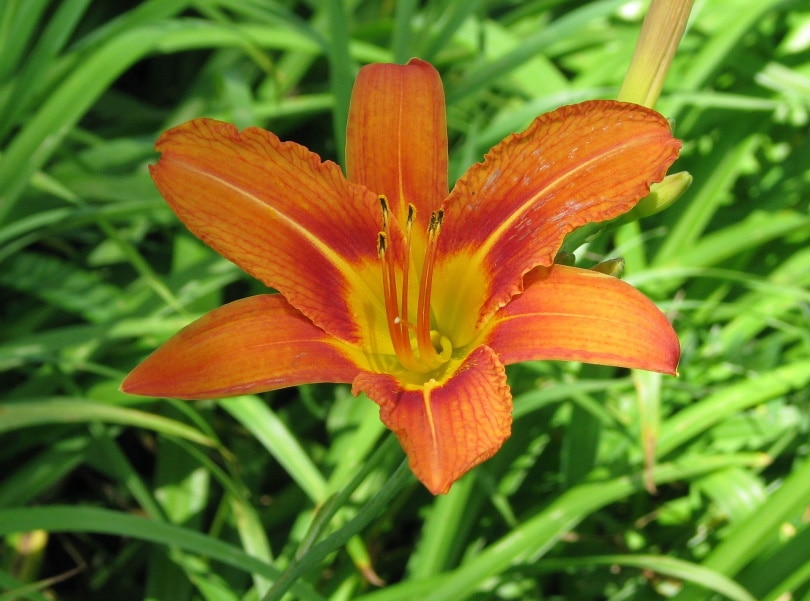
| Scientific Name: | Hemerocallis fulva |
| Bloom Time: | Early to late summer |
| Sun Exposure: | Full sun |
| USDA Hardiness Region: | 3 – 8 |
The orange daylily is an Asian native wildflower that made its way to the United States in the late 18th century. It now grows throughout the eastern United States and parts of the Midwest.
The flower stalk can reach up to 6 feet tall and has bright green sword-shaped leaves. Vibrant orange flowers bloom from early to late summer reaching about 5 inches in diameter. It may grow as a wildflower, but it is also very popular among commercial gardeners.
16. Carolina Lupine
| Scientific Name: | Thermopsis villosa |
| Bloom Time: | May to June |
| Sun Exposure: | Full sun, partial shade |
| USDA Hardiness Region: | 4 – 9 |
The Caroline lupine displays stunning clusters of flowers that bloom from tall spikes. They are native to the mountains of North Carolina and Georgia but unlike other lupines, can also bloom beautifully throughout the Piedmont and coastal plain areas of the state that experience higher heat. Sweat pea-like flowers ranging from yellow to cream in color will bloom during the springtime.
17. Sweet Joe Pye Weed
| Scientific Name: | Eutrochium purpureum |
| Bloom Time: | July to October |
| Sun Exposure: | Full sun, partial shade |
| USDA Hardiness Region: | 4 – 8 |
Sweet Joe Pye weed is a perennial wildflower of the daisy family that is native to the southeastern United States and parts of Canada. It is distributed through upland forests and tolerates more dry soils than your average Pye weed species. Small pale pink to lavender flowers will bloom off large flower heads from July to October.
18. Narrow Leaf Sunflower
| Scientific Name: | Helianthus angustifolius |
| Bloom Time: | August to November |
| Sun Exposure: | Full sun |
| USDA Hardiness Region: | 5 – 9 |
The narrow-leaf sunflower or swamp sunflower is a native perennial that is found across the eastern United States spanning as far west as Texas. It is a very large perennial that can grow up to 8 feet tall and displays showy yellow daisy-like flowers.
Blooms will occur from mid to late summer and until the first frost of the fall. Flowers are about 2 to 3 inches across and will have between 10 and 20 yellow narrow rays surrounding a purplish-brown disk.
19. Bur Marigold
| Scientific Name: | Bidens aristosa |
| Bloom Time: | August to October |
| Sun Exposure: | Full sun, partial shade |
| USDA Hardiness Region: | 5 – 9 |
The Bur Marigold grows to be about 2 to 4 feet in height and is found throughout the entire state of North Carolina. It has large yellow flowers that bloom during the late summer and last until early fall. These wildflowers are sparser in the mountainous regions of the state.
20. Indian Blanket
| Scientific Name: | Gaillardia pulchella |
| Bloom Time: | May to August |
| Sun Exposure: | Full sun, partial shade |
| USDA Hardiness Region: | 5 – 9 |
The Indian Blanket is a stunning wildflower distributed across the southern and central areas of the United States and Northern Mexico. It features disc-shaped vibrant orange-red flowers with yellow tips. The flowers will bloom from May to August and a single plant could have up to 150 flowers. They are very common along roadsides and attract several pollinators.
21. Giant Coneflower
| Scientific Name: | Rudbeckia maxima |
| Bloom Time: | July to September |
| Sun Exposure: | Full sun, light shade |
| USDA Hardiness Region: | 4 – 9 |
Giant Coneflowers are distributed throughout the central and southern United States. The flower stalks appear during the summer featuring 2 to 3 vibrant yellow daisy-like blooms with a very prominent dark center that is 2 to 6 inches tall. Flowers will bloom from July to September and are very popular among butterflies.
22. Black-Eyed Susan
| Scientific Name: | Rudbeckia subtomentosa |
| Bloom Time: | June to September |
| Sun Exposure: | Full sun, light shade |
| USDA Hardiness Region: | 4 – 8 |
The Black-eyed Susan, sometimes referred to as Sweet Coneflower, is a large wildflower that can reach up to 5 feet tall. It is found throughout most of North America but is most common east of the Rocky Mountains. The plant has weedy foliage and vibrant daisy-like blooms with yellow rays and either a black or dark brown center.
23. Blue Mistflower
| Scientific Name: | Conoclinium coelestinum |
| Bloom Time: | July to October |
| Sun Exposure: | Full sun, light shade |
| USDA Hardiness Region: | 5 – 9 |
Blue mistflower grows up to 3 feet tall. It is a late summer bloomer that lasts until the middle of fall. This herbaceous perennial is native to the eastern part of the country and displays tubular blueish-purple flowers that are thistle-like and fluffy in appearance.
24. Blue Sage
| Scientific Name: | Salvia azurea |
| Bloom Time: | June to September |
| Sun Exposure: | Full sun |
| USDA Hardiness Region: | 4 – 9 |
Blue Sage is a beautiful wildflower native to the dry, pine forests of the central and southern United States. It blooms from June to September displaying wand-like clusters of sky-blue, two-lipped tubular flowers that attract many pollinators.
25. Indian Pink
| Scientific Name: | Spigelia marilandica |
| Bloom Time: | May to June |
| Sun Exposure: | Partial to full shade |
| USDA Hardiness Region: | 5 – 7 |
The Indian Pink, or Woodland Pinkroot is native to the southeastern United States. This perennial reaches around 1 to 2 feet tall up to 1 ½ feet wide. It has glossy green leaves with vibrant red tubular flowers that have yellow interiors. The flowers bloom from May to June and are highly attractive to hummingbirds and butterflies.
26. New England Aster
| Scientific Name: | Symphyotrichum novae-angliae |
| Bloom Time: | August to October |
| Sun Exposure: | Full sun, light shade |
| USDA Hardiness Region: | 4 – 8 |
The New England Aster is found throughout most of the United States except for a few areas in the south and western region. This showy perennial reaches up to 6 feet in height and displays pinkish-to-purple flowers.
The stems and branches are light brown to dark brown and are typically covered in short white bristly hairs. The flowers are very large with yellow centers and will bloom from August to October.
27. Common Dandelion
| Scientific Name: | Taraxacum officinale |
| Bloom Time: | April to October |
| Sun Exposure: | Full sun, partial shade |
| USDA Hardiness Region: | 3 – 9 |
Dandelions are incredibly common throughout North America and are highly adaptable to many different weather conditions. The yellow flower reaches 1 to 2 inches across and grows at the end of a hollow stalk.
Once mature, it leaves behind the tufty white portions called the pappi, which will easily disperse in the wind. Dandelions are often considered a weed and people go to great lengths to rid their yards of them, but they also offer some significant health benefits that many are unaware of.
28. Maximilian’s Sunflower
| Scientific Name: | Helianthus maximiliani |
| Bloom Time: | August to September |
| Sun Exposure: | Full sun |
| USDA Hardiness Region: | 4 – 9 |
Maximilian’s Sunflower is common throughout the midwestern United States US and southern Canada but also grows in North Carolina. The plant will reach anywhere from 3 to 10 feet in height with a spread of 2 to 4 feet. The flower head features 15 to 20 vibrant golden yellow ray sunflowers.
This wildflower blooms later in the summer from August to September. Since they are very beautiful and showy while also tolerant of difficult growing conditions, they are often planted in yards and gardens.
29. Blue Vervain
| Scientific Name: | Verbena hastata |
| Bloom Time: | June to September |
| Sun Exposure: | Full sun, partial shade |
| USDA Hardiness Region: | 3 – 8 |
Blue vervain is a common perennial wildflower native to the United States and southern Canada. It has small, thin upward branching spikes ranging from 2 to 5 inches long. It features purplish-blue flowers with five petals that bloom directly from the spikes.
The stems are square and will either be green or red. Leaves reach approximately 7 inches long and 1 inch wide. The entire plant itself will grow to around 2 and 6 feet in height and 1 to 2.5 feet wide.
30. Seashore Mallow
| Scientific Name: | Kosteletzkya virginica |
| Bloom Time: | July to October |
| Sun Exposure: | Full sun |
| USDA Hardiness Region: | 6 – 9 |
Seashore mallow is a native plant found in the marshes and brackish water regions of the east coast. It is a short-lived wildflower with moderate tolerance to salt. It grows anywhere from 3 to 6 feet tall with a 2 to 4-foot spread.
This plant displays stunning pink flowers that resemble the hibiscus and blooms from July through October bringing in a variety of pollinators like hummingbirds and butterflies. The seashore mallow was named the NC Wildflower of the year in 1990.
31. White Turtlehead
| Scientific Name: | Chelone glabra |
| Bloom Time: | July to October |
| Sun Exposure: | Full sun |
| USDA Hardiness Region: | 3 – 8 |
White Turtlehead is a clump-forming wildflower that is Native to the eastern United States and Canada. It is found in moist areas, open woodlands, stream banks, flood plains, and marshes.
This flower blooms tight clusters of white, two-lipped flowers from late summer to fall on 6 to 8-inch spikes. It attracts many pollinators including bees, butterflies, and hummingbirds.
32. Dames Rocket
| Scientific Name: | Hesperis matronalis |
| Bloom Time: | May to August |
| Sun Exposure: | Full sun, partial shade |
| USDA Hardiness Region: | 3 – 8 |
Dames Rocket is a wildflower that originated in Europe and Central Asia but is commonly mistaken for being a North American native because it was brought over by the early settlers.
It is found throughout woodlands, prairies, roadsides, ditches, and other areas often crowding native plants. It blooms fragrant purple to pink flowers with 4 petals from May to August.
33. Foamflower
| Scientific Name: | Tiarella cordifolia |
| Bloom Time: | April to June |
| Sun Exposure: | Shade, dappled light |
| USDA Hardiness Region: | 3 – 8 |
The foamflower is a native species that occurs throughout the Appalachian Mountain region of North Carolina. This small perennial produces small spikes of creamy white to light pink flowers.
This delicate plant is slow growing and cannot withstand drought conditions, which is why it is only common throughout dense, moist forested areas. It was named the NC Wildflower of the Year in 1986.
34. Carolina Campion
| Scientific Name: | Silene caroliniana |
| Bloom Time: | April to May |
| Sun Exposure: | Full sun |
| USDA Hardiness Region: | 5 – 8 |
Carolina campion is often referred to as a sticky catchfly. This perennial wildflower is native to the central and eastern United States thriving in areas of acidic, sandy soil in more open dry woodland areas.
It gets its name “catchfly” from the sticky hairs that are meant to repel insects. This wildflower is low-growing and produces loose clusters of about 50 to 100 flowers per plant.
35. Birthroot
| Scientific Name: | Trillium |
| Bloom Time: | April to May |
| Sun Exposure: | Partial shade |
| USDA Hardiness Region: | 5 – 8 |
Birthroot or trillium refers to a family of over 50 flowering plant species that are native to North America and can be found in North Carolina, mostly throughout the mountainous region,s with some occurring in the Piedmont and coastal areas.
Flowers are solitary with three petals and three bracts. They bloom from April to May and can be yellowish gold, pink, purple, or white. The size of the flowers depends on the specific species of trillium.
In Conclusion
There are so many beautiful wildflowers growing throughout the Tar Heel State. These plants are incredibly important to the local ecosystem and support the local wildlife, especially birds and various pollinators. Starting in spring and lasting through late fall, North Carolina is an excellent destination if you want to witness the incredible, colorful blooms this state has to offer.
Featured Image Credit: Skyprayer2005, Shutterstock
Contents

